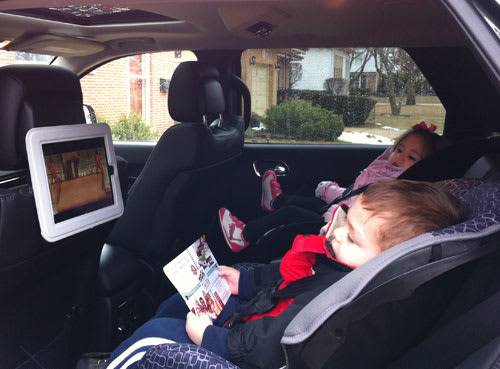NHTSA Recommends Kids Stay in Car Seats, Boosters Longer


CARS.COM — Keeping your kids safe in the car is the priority for any parent. There are countless car seats and booster seats on the market, but many parents struggle to know which is the right fit for their child and their vehicle. When strapping your kids in the backseat, it’s important to choose the safety equipment that works best in your car and will provide the most protection for your family.
Related: Why Do Car Seats Expire?
The National Highway Traffic Safety Administration has revised its child-safety car seat and booster seat guidelines to make them easier for parents to follow. The new car seat and booster seat guidelines now focus on a child’s age and recommend that parents keep their children in the appropriate car seats or booster seats for as long as possible to ensure maximum safety — ideally, until the child reaches the car seat’s height or weight limits. Using the right seat or booster in the car enhances safety and prevents injuries and death during car accidents. Until your child fits properly in your car’s seat and can use the seat belt in the vehicle appropriately, they should be kept in the appropriate safety seat.
“Selecting the right seat for your child can be a challenge for many parents,” NHTSA administrator David Strickland said in a press release. “NHTSA’s new revised guidelines will help consumers pick the appropriate seat for their child.” The new NHTSA guidelines for car seats and booster seats are below. In addition to these guidelines, remember that infants, toddlers and young children should always be seated in the back seat of a vehicle to ensure maximum safety.
Birth to 12 months old
- A child younger than 1 should always ride in a rear-facing car seat.
- There are different types of rear-facing car seats. Infant-only seats can only be used rear-facing. Convertible and 3-in-1 car seats typically have higher height and weight limits for the rear-facing position, allowing you to keep your child rear-facing for a longer time period. Some convertible rear-facing seats can also eventually be used as booster seats.
1 to 3 years old
- Keep your child rear-facing in an appropriate seat for as long as possible. It’s the best way to keep him or her safe. Your child should remain in a rear-facing car seat until he or she reaches the top height or weight limit allowed by your car seat’s manufacturer. Once your child outgrows the rear-facing car seat, they are ready to travel in a forward-facing car seat with a harness. Convertible forward-facing seats are good options that help parents save money when switching from this type of car seat to a booster seat.
4 to 7 years old
- Keep your child in a forward-facing seat with a harness until he or she reaches the top height or weight limit allowed by your car seat’s manufacturer. Once your child outgrows the forward-facing car seat with a harness, it’s time to travel in a booster seat but still in the backseat. A booster seat helps position small children so the vehicle’s seat belt and shoulder belt fit like they should.
8 to 12 years old
- Don’t rush to let your kids use your car’s seat belt by itself too quickly. Keep your child in a booster seat until he or she is big enough to fit in a seat belt properly. For a seat belt to fit properly, the lap belt must lie snugly across the upper thighs, not the stomach. The shoulder belt should lie snug across the shoulder and chest and not cross the neck or face. Remember: Your child should still ride in the backseat of the vehicle because it’s safer there.
These new guidelines mean that kids will be in nearly all of their child-safety seats for a longer period of time. Parents should no longer change the position of a rear-facing convertible to forward-facing when a child turns 1. Many parents may wonder if an 18-month-old or 2-year-old will fit in a rear-facing car seat, but the child can simply fold their legs or sit cross-legged.
Parents also should keep their children out of the front seat until they’re 13 years old. If they are small and the lap belt or shoulder belt does not fit appropriately, they should be kept in the back seat until they do. An American Academy of Pediatrics study published today in the journal Pediatrics also recommends keeping young children in rear-facing car seats for as long as possible.
To learn more about NHTSA’s recommendations for car seats and booster seats, click here.
Cars.com’s Editorial department is your source for automotive news and reviews. In line with Cars.com’s long-standing ethics policy, editors and reviewers don’t accept gifts or free trips from automakers. The Editorial department is independent of Cars.com’s advertising, sales and sponsored content departments.

Editor-in-Chief Jennifer Newman is a journalist with more than 25 years of experience, including 15 years as an automotive journalist at Cars.com. Jennifer leads the Editorial team in its mission of helping car shoppers find the vehicle that best fits their life. A mom of two, she’s graduated from kids in car seats to teens behind the steering wheel. She’s also a certified car-seat technician with more than 12 years of experience, as well as member of the World Car Jury, Automotive Press Association and Midwest Automotive Media Association. LinkedIn: https://www.linkedin.com/in/jennilnewman/ Instagram: @jennilnewman
Featured stories



